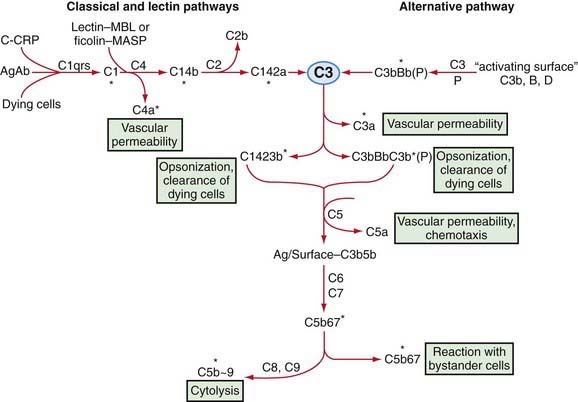Chapter 127 The Complement System
Complement was originally defined as the nonspecific, heat-labile complementary principle required with specific antibody to lyse bacteria. The 1st 4 components were numbered in the order of their discovery and are termed the classical pathway. Unfortunately, the components fix to the immune complex in a different order, C1423. Beyond this confusing start, complement is a logical, exquisitely balanced, and highly influential system that is fundamental to the clinical expression of host defense and inflammation.
The complement system, an essential component of innate immunity, is broadly conceptualized as the classical, lectin, and alternative pathways, which interact and depend on each other for their full activity; the membrane attack complex (C5b6789), formed from activity of any pathway; the 8 serum and 4 membrane regulatory proteins that are defined to date; and 8 fully defined cell membrane receptors that bind complement components or fragments (Table 127-1). The 27 circulating components and regulators together compose about 15% of the globulin fraction of serum. The normal concentrations of serum complement components vary by age (Chapter 708); newborn infants have mild to moderate deficiencies of all components.
Table 127-1 CONSTITUENTS OF THE COMPLEMENT SYSTEM
SERUM COMPONENTS
Classical Pathway
C1q
C1r
C1s
C4
C2
C3
Alternative Pathway
Factor B
Factor D
Lectin Pathway
Mannose-binding lectin (MBL), ficolins 1, 2, 3 (M, L, H, respectively)
MBL-associated serine proteases (MASPs) 1, 2
Membrane Attack Complex
C5
C6
C7
C8
C9
Regulatory Protein, Enhancing
Properdin
Regulatory Proteins, Downregulating
C1 inhibitor (C1 INH)
C4-binding protein (C4-bp)
Factor H
Factor I
S protein (vitronectin)
Clusterin
Carboxypeptidase N (anaphylatoxin inactivator)
MEMBRANE REGULATORY PROTEINS
CR1 (CD35)
Membrane cofactor protein (MCP; CD46)
Decay-accelerating factor (DAF, CD55)
CD59 (membrane inhibitor of reactive lysis; protectin)
MEMBRANE RECEPTORS
CR1 (CD35)
CR2 (CD21)
CR3 (CD11b/CD18)
CR4 (CD11c/CD18)
C3a receptor
C5a receptor
C1q receptors
Complement receptor of the Ig superfamily (CRIg)
CR, complement receptor; Ig, immunoglobulin.
After C1423, complement nomenclature is logical and consists of only a few rules. Fragments of components resulting from cleavage by other components acting as enzymes are assigned lowercase letters (a, b, c, d, e); with the exception of C2 fragments, the smaller piece that is released into surrounding fluids is assigned the lowercase letter a, and the major part of the molecule, bound to other components or to some part of the immune complex, is assigned letter b—for example, C3a and C3b. Components of the alternative pathway, B and D, have been assigned uppercase letters, as have the control proteins I and H, which downregulate both pathways. C3, and especially its major fragment C3b, is a component of both the classical and alternative pathways.
Complement is a system of interacting proteins. The biologic functions of the system depend on the interactions of individual components, which occur in sequential, cascade fashion. Activation of each component, except the 1st, depends on activation of the prior component or components in the sequence. Interaction occurs along three pathways (Fig. 127-1): the classical pathway, in the order antigen–antibody–C142356789; the lectin (carbohydrate-binding) pathway, in the order microbial carbohydrate–lectin (mannose-binding lectin [MBL] or ficolin)–MBL-associated serine protease–C42356789; and the alternative pathway, in the order activator–C3bBD–C356789. Antibody accelerates the rate of activation of the alternative pathway, but activation can occur on appropriate surfaces in the absence of antibody. The classical and the alternative pathways interact with each other through the ability of both to activate C3.

Figure 127-1 Sequence of activation of the components of the classical and lectin pathways of complement and interaction with the alternative pathway. Activation of C3 is the essential target. Functional activities generated during activation are enclosed in boxes. The multiple sites at which inhibitory regulator proteins (not shown) act are indicated by asterisks,
Stay updated, free articles. Join our Telegram channel

Full access? Get Clinical Tree


